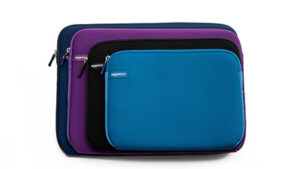Hey there, curious mind! Ever wondered what makes those snug wetsuits and sleek laptop sleeves so effective and durable? The secret lies in the material they’re made of: neoprene fabric. Let’s dive into the world of neoprene, uncover its unique properties, and explore its wide range of applications. Whether you’re a water sports enthusiast, a tech junkie, or just someone who loves innovative materials, this guide is for you.
What Is Neoprene Fabric?

Neoprene, also known as polychloroprene, is a type of synthetic rubber invented in the 1930s by DuPont scientists. Originally developed as an oil-resistant alternative to natural rubber, neoprene has since become a versatile and widely-used material. Its combination of durability, flexibility, and water resistance makes it a go-to choice for various industries.
What Is Neoprene Made Of?
Neoprene is created through the polymerization of chloroprene, a process that links molecules together to form long chains. These chains give neoprene its unique properties, making it robust and stretchy. Think of it as a giant molecular rubber band that’s tough enough to handle harsh environments but flexible enough to mold into various shapes and forms.
Properties of Neoprene Fabric

Physical Properties
Durability
Neoprene is incredibly durable, withstanding wear and tear that would quickly degrade other materials. This makes it perfect for items that face rough conditions, like wetsuits or protective gear.
Flexibility
One of neoprene’s standout features is its flexibility. It can stretch and return to its original shape without losing its integrity, making it comfortable and form-fitting for wearables.
Thickness and Density Variations
Neoprene comes in various thicknesses and densities, allowing manufacturers to tailor its properties to specific applications. Thicker neoprene provides better insulation and cushioning, while thinner neoprene offers more flexibility and a closer fit.
Chemical Properties
Resistance to Chemicals
Neoprene’s chemical resistance is one of its greatest strengths. It can withstand exposure to oils, solvents, and other chemicals, making it ideal for industrial applications and protective gear.
Thermal Insulation
Thanks to its closed-cell structure, neoprene provides excellent thermal insulation. It traps heat, keeping you warm in cold water or chilly environments, which is why it’s a favorite material for wetsuits.
Water Resistance
Neoprene’s water resistance is legendary. It’s virtually waterproof, preventing water from penetrating its surface. This property is why it’s commonly used in aquatic and water-resistant products.
Mechanical Properties
Tensile Strength
Neoprene boasts impressive tensile strength, meaning it can stretch significantly without breaking. This is crucial for applications where flexibility and strength are both required.
Compression Resistance
When compressed, neoprene can return to its original shape, maintaining its protective and cushioning properties. This makes it ideal for products like knee pads and laptop sleeves.
Abrasion Resistance
Neoprene is tough enough to resist abrasion, adding to its longevity. This durability is especially important for items exposed to friction and constant movement.
Advantages of Neoprene Fabric

Versatility
Neoprene’s versatility is unmatched. It’s used in everything from fashion to industrial applications, thanks to its unique combination of properties. Whether it’s for a wetsuit or a laptop sleeve, neoprene fits the bill.
Durability
Neoprene’s durability ensures that products made from it last a long time, even under tough conditions. This longevity makes it a cost-effective choice in the long run.
Comfort and Fit
Neoprene’s flexibility and stretch provide a comfortable and snug fit, whether it’s in wearable items like wetsuits or in protective gear. It molds to the body, offering support without restricting movement.
Disadvantages of Neoprene Fabric
Environmental Impact
One of neoprene’s significant downsides is its environmental impact. The production process involves chemicals that aren’t eco-friendly, and neoprene itself isn’t biodegradable. However, efforts are underway to develop more sustainable alternatives.
Cost
Neoprene can be more expensive than other materials due to its manufacturing process and unique properties. This higher cost can be a barrier for some applications, especially in budget-conscious markets.
Breathability Issues
Neoprene isn’t very breathable, which can lead to discomfort when worn for extended periods in warm conditions. This is a trade-off for its excellent water and thermal resistance.
Applications of Neoprene Fabric

Fashion and Apparel
Wetsuits and Swimwear
Neoprene’s water resistance and thermal insulation make it perfect for wetsuits and swimwear. It keeps you warm in cold water while allowing freedom of movement.
Sportswear and Accessories
In addition to swimwear, neoprene is used in various sportswear and accessories, like gloves, boots, and knee pads. Its flexibility and durability provide both comfort and protection.
Industrial Uses
Gaskets and Seals
Neoprene’s chemical and abrasion resistance make it ideal for gaskets and seals in industrial settings. It ensures a tight seal, preventing leaks and maintaining safety.
Protective Gear
From safety gloves to aprons, neoprene is widely used in protective gear. Its resistance to chemicals and physical wear makes it a reliable choice for hazardous environments.
Medical Applications
Supports and Braces
Neoprene’s flexibility and compression properties make it an excellent material for medical supports and braces. It provides stability and support without sacrificing comfort.
Orthopedic Products
Orthopedic products like insoles and cushions benefit from neoprene’s cushioning and durability. It helps in distributing pressure evenly, providing comfort and support.
Consumer Goods
Laptop Sleeves and Bags
Neoprene’s cushioning and protective qualities make it a popular choice for laptop sleeves and bags. It shields electronics from bumps and scratches while being lightweight and stylish.
Household Items
From coasters to mouse pads, neoprene is found in various household items. Its durability and ease of cleaning make it a practical choice for everyday use.
Care and Maintenance
How to Clean Neoprene Fabric?
Cleaning neoprene is simple. Use a mild detergent and cold water to gently scrub away dirt and grime. Avoid harsh chemicals and hot water, as they can damage the fabric. Rinse thoroughly and let it air dry away from direct sunlight.
Storage Recommendations
Store neoprene items flat or rolled to prevent creasing. Keep them in a cool, dry place away from direct sunlight and heat sources. This helps maintain their shape and prolongs their lifespan.
Conclusion
Neoprene fabric is a marvel of modern materials, offering a unique combination of durability, flexibility, and water resistance. From keeping surfers warm in icy waters to protecting our gadgets from bumps and scrapes, neoprene’s versatility is truly impressive. Despite its environmental impact and cost, its benefits often outweigh these drawbacks, making it a material that’s hard to beat.
FAQs on Neoprene Fabric
1. Is neoprene waterproof?
Yes, neoprene is highly water-resistant, making it an excellent material for wetsuits and other aquatic applications.
2. What is neoprene made of?
Neoprene is made from the polymerization of chloroprene, creating a synthetic rubber known for its durability and flexibility.
3. How do you clean neoprene fabric?
Clean neoprene with mild detergent and cold water. Avoid using harsh chemicals or hot water, and let it air dry away from direct sunlight.
4. What are the disadvantages of neoprene?
Neoprene’s main disadvantages are its environmental impact, higher cost compared to some materials, and lack of breathability.
5. What are common uses of neoprene?
Common uses of neoprene include wetsuits, sportswear, industrial gaskets and seals, medical supports, laptop sleeves, and various household items.








